Q.1. A dice with six faces is marked with six numbers 1, 2, 3, 4, 5 and 6 respectively. This dice is rolled three times and three positions are shown as:
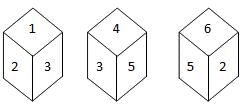
Find the number opposite to 1.
A. 2
B. 6
C. 5
D. 4
Answer: C
Explanation:
From figures (ii) and (iii), we can conclude that the numbers 2, 4, 3, and 6 appear adjacent to the letter 5. Therefore, the number 1 appears opposite to 5. In other words, 5 appears opposite to 1.
Q.2. You are given three positions of dice then which face is opposite to the face with alphabet B?
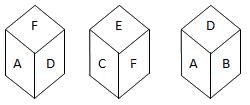
A. E
B. F
C. D
D. A
Answer: B
Explanation:
From figures (i) and (ii), we can conclude that the alphabets C, D, A and E lie adjacent to the alphabet F. So, the alphabet B lies opposite F and conversely F lies opposite B.
Q.3. Which face is opposite to face with alphabet B, if four positions are given as below as?

A. B
B. A
C. F
D. E
Answer: D
Explanation:
From figures (i), (ii) and (iv), we can conclude that F, D, C and A lie adjacent to B. Hence, E must lie opposite to B.
Q.4. Which of the following patterns can be formed from the piece of cardboard (X) as shown below?
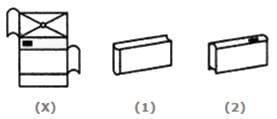

A. 4
B. 2
C. 1
D. 3
Answer: C
Explanation:
The pattern on the fig. (X) and the fact that the faces are rectangular and fig.(2) is eliminated as dot on the upper face is on left side instead of right.
Fig. (3) and fig.(4) also get eliminated as the smaller rectangular faces should be blank instead of having a dot on them.
So, fig.(1) is the only possible fig as it is having three blank faces adjacent to each other.
Directions for questions 5 to 9: Six different positions of dice are given below:
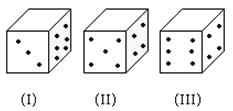
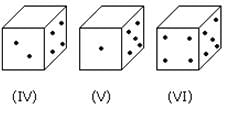
The sum of the numbers of dots on the opposite face is 7.
Q.5. If an even numbered dice have an odd number of dots on their top faces, then find the total number of dots on the top faces of their dice?
A. 22
B. 3
C. 10
D. 24
Answer: B
Explanation:
Even numbered dice are: (II), (IV) and (VI)
Number of dots on the top face of (II) dice = 1
Number of dots on the top face of (IV) dice = 1
Number of dots on the top face of (VI) dice = 1
Therefore, the required total = 1+1+1=3
Q.6. If an odd numbered dice have an odd number of dots on their top faces, then find the total number of dots on top faces of their dice is?
A. 11
B. 12
C. 13
D. 14
Answer: C
Explanation:
Odd numbered dice are : (II), (III) and (V)
Numbers of dots on the top faces of these dice are 5, 5 and 3 respectively.
Required total = 5+5+3=13|
Q.7. . If dice (I), (II) and (III) have an odd number of dots on their top faces, and the dice (IV), (V) and (VI) have an even number of dots on their top faces, then what is the difference in the total number of top faces between the two sets?
A. 0
B. 3
C. 1
D. -5
Answer: D
Explanation:
Number of faces on the top faces of the dice (I), (II) and (III) are 5, 1 and 5 respectively.
Therefore, the total of these numbers = 5 + 1 + 5 = 11
Number of dots on the top faces of the dice (IV), (V) and (VI) are 6, 4 and 6 respectively.
Therefore, the total of these numbers = 6+4+6=16
Required difference = 11 -16=-5
Q8. If the odd numbers of dice have an even number of dots on their top faces and an even numbered dice have an odd of dots on their bottom faces, then what is the total number of dots on their top faces?
A. 26
B. 12
C. 16
D. 18
Answer: A
Explanation:
Number of dots on the top faces of the dice (II), (IV) and (VI) are 2, 2 and 4 respectively.
Number of dots on the top faces of the dice (I), (III) and (V) are 6, 6 and 6 respectively.
Required total = 2 + 2 + 4 + 6 + 6 + 6 =26
Q9. If the dice (I), (II) and (III) have an odd number of dots on their top faces, then what is the total number of dots on their top faces?
A. 7
B. 14
C. 12
D. 11
Answer: D
Explanation:
No. of dots on the top faces of dice (I), (II) and (III) are 5, 1 and 5 respectively.
Required total = 5 + 1 + 5 = 11
Q10.Refer to the following four positions of the dice and find out the color which is opposite the face grey?

A. Golden
B. Purple
C. Brown
D. Green
Answer: A
Explanation
The colors adjacent to grey are green, pink, purple and brown. Hence golden will be opposite to grey.




























